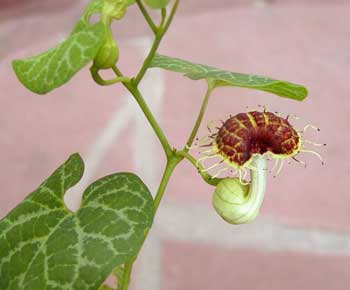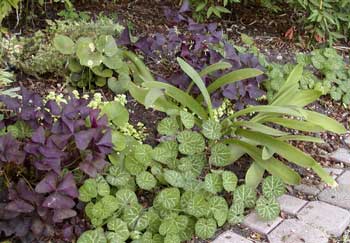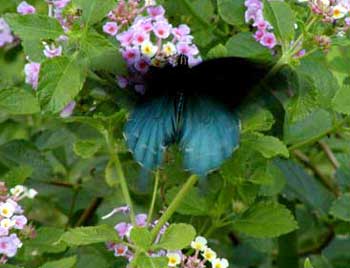Dutchman's Pipevine
Native Pipe Vine
Aristolochia fimbriata

. . . for hosting iridescent blue and black
pipevine swallowtail butterflies
Common Name: Dutchman's Pipevine
Botanical Name: Aristolochia fimbriata
Design Tip: Use along pathways or on the edge of a naturalized woodland setting as a ground hugging plant or between plants and shrubs in a mixed border.
Form: This variety of Aristolochia is a small ground-cover type perennial vine that returns from tuber-like roots.
Size: The herbaceous A. fimbriata attains a three-foot wide mound in the growing season. In contrast, two other Texas-indigenous varieties, A. durior and tomentosa, grow large enough to cover trellis and fencing.
Flowers: One-inch exotic blooms of yellow and maroon resemble a trumpet shaped clay pipe; hence the common name. Blooms appear on new growths throughout the summer.
Foliage: The three-inch heart shaped green leaves are widely spaced along wiry stems and are marked with silver veins.
Soil: It prefers a well-draining moist, rich soil.
Light Exposure: Morning sun with afternoon shade produces best bloom and growth. Although, it will accept full shade or live in full sun with regular irrigation.
Hardiness: USDA Zones 7-10
Propagation: It will self-sow from the previous season's seed, taking at least 3 months to germinate.
Where to get it: Find it at nurseries specializing in native and adapted plants and from mail order suppliers on the web including http://www.plantdelights.com
Snippets: This is the only plant where the pipevine swallowtail butterfly will lay its eggs. If a healthy crop of caterpillars devour the entire above-ground growth, more will return from the tuberous roots to host the next batch of eggs. The more plants you have, the more iridescent-blue and black butterflies your garden can accommodate.

The Pipevine Swallowtail butterfly lays it eggs on
Aristolochia fimbriata pipevine - above

and feeds from other nectar bearing plants.
Cultivated, photographed and written by
Maggie Ross McNeely in Fort Worth, Texas
All rights reserved